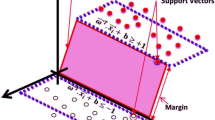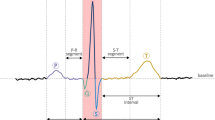Abstract
The classification of heart beats is important for automated arrhythmia monitoring devices. The study describes two different classifiers for the identification of premature ventricular complexes (PVCs) in surface ECGs. A decision-tree algorithm based on inductive learning from a training set and a fuzzy rule-based classifier are explained in detail. Traditional features for the classification task are extracted by analysing the heart rate and morphology of the heart beats from a single lead. In addition, a novel set of features based on the use of a filter bank is presented. Filter banks allow for time-frequency-dependent signal processing with low computational effort. The performance of the classifiers is evaluated on the MIT-BIH database following the AAMI recommendations. The decision-tree algorithm has a gross sensitivity of 85.3% and a positive predictivity of 85.2%, whereas the gross sensitivity of the fuzzy rule-bassed system is 81.3%, and the positive predictivity is 80.6%.
Similar content being viewed by others
References
Association for the Advancement of Medical Instrumentation (1998): ‘Testing and reporting performance results of ventricular arrhythmia detection algorithms’. AAMI, 3330 Washington Blvd., Suite 400, Arlington, VA 22201, USA
Afonso, V. X., Tompkins, W. J., Nguyen, T. Q., Michler, K., andLuo, S. (1966): ‘Comparing stress ECG enhancement algorithms: with an introduction to a filter bank based approach’,IEEE Eng. Med. Biol. Mag.,15, pp. 37–44
Afonso, V. X., Wieben, O., Tompkins, W. J., Nguyen, T. Q., andLuo, S. (1997): ‘Filter bank-based ECG beat classification’, Proc. Ann. Int. Conf. IEEE Eng. Med. Biol. Soc.,19, pp. 97–100.
Afonso, V. X., Tompkins, W. J., Nguyen, T. Q., andLuo, S. (1999): ‘ECG beast detection using filter banks’,IEEE Trans.,BME-46, pp. 192–202.
Bezdek, J. C. (1981): ‘Pattern recognition with fuzzy objective function algorithms’ (Plenum Press, New York)
Chow, H. S., Moody, G. B., andMark, R. G. (1992): ‘Detection of ventricular ectopic beats using neural networks’, Comput. in Cardiol. Conf. 1992, IEEE Computer Society Press, pp. 659–662
Clayton, R. H., Murray, A., andCampbell, R. W. F. (1995): ‘Objective features, of the surface electrocardiogram during ventricular tachyarrhythmias’,Eur. Heart J.,16, pp. 115–1119
Dassen, W. R., Karthaus, V. L., Talmon, J. L., Mulleneers, R. G., Smeets, J. L., andWellens, H. J. (1995): ‘Evaluation of new self learning techniques for the generation of criteria for differentiation of wide-QRS tachycardia in supraventricular tachycardia and ventricular tachycardia’,Clin. Cardiol.,18, pp. 103–108
Gulley, N., andJang, J. S. (1995): ‘Fuzzy logic toolbox for use with MATLAB’ (MathWorks Inc, Natick, MA)
Ham, F. M., andHan, S. (1996): ‘Classification of cardiac arrhythmias using fuzzy ARTMAP’,IEEE Trans.,BME-43, pp. 425–430
Hamdan, M., andScheinman, M. (1995): ‘Current approaches in patients with ventricular tachyarrhythmias’,Med. Clin. North Am.,79, pp. 1097–1120
Hu, Y. H., Tompkins, W. J., Urrusti, J. L., andAfonso, V. X. (1994): ‘Applications of artificial neural networks for ECG signal detection and classification’,J. Electrocardiol.,26, (suppl.), pp. 66–73
Jenkins, J. M., andCaswell, S. A. (1996): ‘Detection algorithms in implantable cardioverter defibrillators’,Proc. IEEE,84, pp. 428–445
Kohavi, R., Sommerfield, D., andDougherty, J. (1996): ‘Data mining using MLC++: a machine learning library in C++’. Proc. Tools in Artificial Intelligence, IEEE Computer Society Press pp. 234–245
Malvar, H. S. (1992): ‘Signal processing with lapped transfroms’ (Artech House, Norwood, MA)
Mendel, J. M. (1995): ‘Fuzzy logic systems for engineering: a tutorial’,Proc. IEEE,83, pp. 345–377
Moody, G. B., andMark, R. G. (1982): ‘Development and evaluation of a 2-lead ECG analysis program’, Comput. in Cardiol. Conf., IEEE Computer Society Press, pp. 39–44
Quinlan, J. R. (1986): ‘Induction of decision trees’,Mach. Learn.,1, pp. 81–106
Rappaport, S. H., Gillick, L., Moody, G. B., andMark, R. G. (1982): ‘QRS morphology classification: quantitative evaluation of different strategies’. Comput. in Cardiol. Conf., IEEE Computer Society Press, pp. 33–38
Ripley, K. L., Bump, T. E., andArzbaeche, R. C. (1989): ‘Evaluation of techniques for recognition of ventricular arrhythmias by implanted devices’,IEEE Trans.,BME-36, pp. 618–624
Silipo, R., Taddei, A., Varanini, M., andMarchesi, C. (1995): ‘Classification of arrhythmic events in ambulatory electrocardiogram, using artificial neural networks,’Comput. Biomed. Res.,28, pp. 305–318
Soman, A. K., Vaidyanathan, P. P., andNguyen, T. Q. (1993): ‘Linear phase paraunitary filter banks: theory, factorizations and designs’,IEEE Trans. Signal Process.,41, pp. 3480–3495
Thakor, N. V., Webster, J. G., andTompkins, W. J. (1984): ‘Estimation of QRS complex power spectra for design of a QRS filter’,IEEE Trans.,BME-31, pp. 702–706
Wang, J. Y. J. (1983): ‘Application of pattern recognition techniques to QRS complex classification—a review’, Comput. in Cardiol. IEEE Computer Society Press pp. 77–82
Wieben, O., Afonso, V. X., andTompkins, W. J. (1997): ‘Classification of PVCs with a fuzzy logic system’, Proc. Ann. Int. Conf. IEEE Eng. Med. Biol. Soc., Nov. 1997,19, pp. 65–67.
Zadeh, L. (1965): ‘Fuzzy sets’,Inf. Control,8, pp. 338–352
Author information
Authors and Affiliations
Corresponding author
Rights and permissions
About this article
Cite this article
Wieben, O., Afonso, V.X. & Tompkins, W.J. Classification of premature ventricular complexes using filter bank features, induction of decision trees and a fuzzy rule-based system. Med. Biol. Eng. Comput. 37, 560–565 (1999). https://doi.org/10.1007/BF02513349
Received:
Accepted:
Issue Date:
DOI: https://doi.org/10.1007/BF02513349




